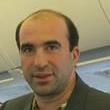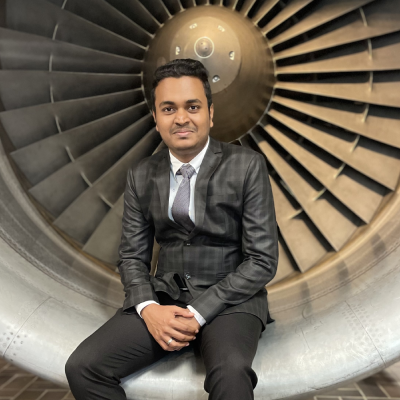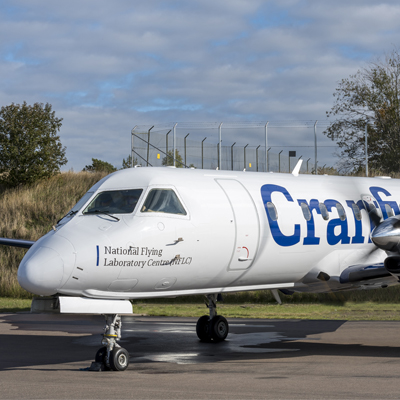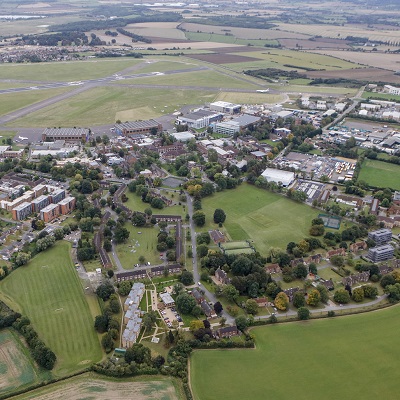Overview
- Start dateSeptember
- DurationFull-time MSc: One year
- DeliveryTaught modules 10% | Group project 50% | Individual research project 40%
- QualificationMSc
- Study typeFull-time
- CampusCranfield campus
Who is it for?
Manufacturers of modern aircraft are demanding more lightweight and more durable structures. Structural integrity is a major consideration of today’s aircraft fleet. For an aircraft to economically achieve its design specification and satisfy airworthiness regulations, a number of structural challenges must be overcome. This course trains engineers to meet these challenges, and prepares them for careers in civil and military aviation. It is suitable if you have a background in aeronautical or mechanical engineering, or relevant industrial experience.
Why this course?
We have been at the forefront of postgraduate education in aerospace engineering since 1946. Aerospace Vehicle Design at Cranfield University was one of the original foundation courses of the College of Aeronautics. Graduates of this course are eligible to join the Cranfield College of Aeronautics Alumni Association (CCAAA), an active community which hold a number of networking and social events throughout the year.
You will have the opportunity to fly during a Student Experience Flight in our National Flying Laboratory Centre’s (NFLC) light aircraft. This flight experience will complement your MSc studies, focussing on the effects of controls, aircraft stability and angle of attack. During the flight you will have the opportunity to take control of the aircraft. Each experience is 2 to 3 hours in duration and includes a pre-flight safety briefing outlining the details of the manoeuvres to be flown, a flight of approximately 1 hour, and a post-flight debrief. Read Hari's blog on his flight experience.
Cranfield University is well located for students from all over the world, and offers a range of library and support facilities to support your studies. This enables students from all over the world to complete this qualification whilst balancing work/life commitments.
Informed by industry
The course has an Industrial Advisory Committee with senior members from major UK aerospace companies, government bodies and the military services. The committee meets twice a year to review and advise on course content, acquisition skills and other attributes are desirable from graduates of the course. Panel members include:
• Airbus,
• BAE Systems,
• Boeing,
• Department of National Defence and the Canadian Armed Forces,
• GKN Aerospace,
• Messier-Dowty,
• Royal Air Force,
• Royal Australian Air Force,
• Thales UK.
We also arrange visits to sites such as BAE Systems, Marshall Aerospace, GKN and RAF bases which specialise in the maintenance of military aircraft. This allows you to get up close to the aircraft components and help with your understanding.
Course details
This option comprises nine compulsory modules and 11 optional modules. You are also required to complete a group design project and an individual research project. Delivered via a combination of structured lectures, industry guest lectures, computer based workshops and private study.
A unique feature of the course is that we have four external examiners: two from industry who assess the group design project and two from academia who assess the individual research project.
Course delivery
Taught modules 10% | Group project 50% | Individual research project 40%
Group Project
The extensive group design project is a distinctive and unique feature of this course. This teamwork project takes place over six months and recreates a virtual industrial environment bringing together students with various experience levels and different nationalities into one integrated design team.
Students are given responsibility for the detailed design of a significant part of the aircraft, for example, forward fuselage, fuel system, landing gear, environmental control system or wing. The project will progress from the conceptual phase through to the preliminary and detail design phases. You will be required to run project meetings, produce engineering drawings and detailed analyses of your design. Problem solving and project coordination must be undertaken on a team and individual basis. At the end of the project, groups are required to report and present findings to a large panel of senior engineers from industry.
This element of the course is both realistic and engaging, and places the student group in a professional role as aerospace design engineers. Students testify that working as an integrated team on real problems is invaluable and prepares them well for careers in a highly competitive industry.
Individual project
The individual research project aims to provide the training necessary for you to apply knowledge from the taught element to research, and takes place from January to September. It is sometimes associated with a real-world problem that one of our industry partners are looking to resolve.
Examples in aircraft structural design and analysis topics:
Investigation in the numerical representation of damage on CFRP stiffened panels and behaviour under combined loading;
Delamination growth of carbon fibre composites under fatigue loads;
Experimental testing and numerical analysis of aircraft bolt jointed sandwich composites;
Strength prediction via testing and/or numerical simulation of bolted joints on fibre reinforced laminates;
Composite design considerations for trailing arm landing gears;
Fatigue behaviour of bolted joints on CFRP laminates following pull through failure;
Simulation of thermal residual stresses of CFRP wing;
Fatigue of buckled composite stiffened panel;
Dynamic Indentation of composite laminates;
Numerical modelling of through-thickness reinforced composite laminates;
Direct measurement of traction-separation law in fatigue damage of adhesive bonding;
Composite joints reinforced by composite fasteners.
Modules
Keeping our courses up-to-date and current requires constant innovation and change. The modules we offer reflect the needs of business and industry and the research interests of our staff and, as a result, may change or be withdrawn due to research developments, legislation changes or for a variety of other reasons. Changes may also be designed to improve the student learning experience or to respond to feedback from students, external examiners, accreditation bodies and industrial advisory panels.
To give you a taster, we have listed the compulsory and elective (where applicable) modules which are currently affiliated with this course. All modules are indicative only, and may be subject to change for your year of entry.
Course modules
Compulsory modules
All the modules in the following list need to be taken as part of this course.
Design and Analysis of Composite Structures
| Aim |
To introduce you to the composite materials, manufacturing techniques and analysis methods for the design of aerospace composite structures. |
|---|---|
| Syllabus |
|
| Intended learning outcomes |
On successful completion of this module you should be able to:
|
Loading Actions
| Aim |
To provide you with knowledge of all the main loading cases including those encountered on the ground, in the air and those induced by the environment. |
|---|---|
| Syllabus |
|
| Intended learning outcomes |
On successful completion of this module you should be able to:
|
Detail Stressing
| Aim |
|
|---|---|
| Syllabus |
|
| Intended learning outcomes |
On successful completion of this module you should be able to:
|
Reliability, Safety Assessment and Certification
| Aim |
To provide you with an introduction to the aircraft airworthiness as well as knowledge of reliability assessment methods, safety assessment methods, and certification issues associated with the design of Aircraft Systems (including weapon systems and survivability). To familiarise you with current air accidents investigation techniques and processes. |
|---|---|
| Syllabus |
|
| Intended learning outcomes |
On successful completion of this module you should be able to:
|
Design for Manufacture and Operation
| Aim |
To ensure that while you design your structure they are aware of the constraint imposed by manufacturing and operational considerations. The influence of designing for maintainability will have a considerable effect on the design of both the structure and aircraft systems and a considerable effect on the life cycle cost of the vehicle. The taught material will have immediate practical application to the Group Design Project. |
|---|---|
| Syllabus |
|
| Intended learning outcomes |
On successful completion of this module you should be able to:
|
Finite Element Analysis
| Aim |
|
|---|---|
| Syllabus |
|
| Intended learning outcomes |
On successful completion of this module you should be able to:
|
Initial Aircraft Design
| Module Leader |
|
|---|---|
| Aim |
|
| Syllabus |
|
| Intended learning outcomes |
On successful completion of this module you should be able to:
|
Structural Stability
| Aim |
To provide you with a fundamental understanding of the buckling of thin walled structures and the ability to calculate the buckling load of a component. |
|---|---|
| Syllabus |
|
| Intended learning outcomes |
On successful completion of this module you should be able to: 1. Demonstrate a conceptual understanding of the buckling of thin walled structures and structural components, 2. Demonstrate the ability to predict buckling behaviour using hand calculation techniques, 3. Analyse the buckling and post buckling behaviour of simple thin walled stiffened panels, 4. Effectively use data sheets to analyse buckling of real structural components. |
Fatigue, Fracture Mechanics and Damage Tolerance
| Aim |
To provide you with an understanding of the theories of Fatigue and Fracture Mechanics, and to demonstrate how these methods and the damage tolerance design concepts are applied to the design and testing of aircraft structures and Airworthiness Certification |
|---|---|
| Syllabus |
|
| Intended learning outcomes |
On successful completion of this module you should be able to:
|
Elective modules
Seven of the modules from the following list need to be taken as attendance only modules.
Design of Airframe Systems
| Module Leader |
|
|---|---|
| Aim |
|
| Syllabus |
|
| Intended learning outcomes |
On successful completion of this module you should be able to:
|
Aircraft Aerodynamics
| Module Leader |
|
|---|---|
| Aim |
The aim of this module is to provide you with the knowledge of the Atmosphere and of the basic aerodynamic characteristics of a conventional aircraft in the context of its mechanics of flight. |
| Syllabus |
This module has additional accompanying flying laboratory tutorials in the Jetstream Aircraft. See Flight Experimental Methods (FXM). |
| Intended learning outcomes |
On successful completion of this module a you should be able to:
|
Computer Aided Design
| Aim |
The aim of this module is to introduce you to the role of Computer Aided Design technologies in a modern Integrated Product Development process and provide hands-on experience of CAD using the CATIA v5 software. |
|---|---|
| Syllabus |
Introduction to Integrated Product Development (IPD) for aircraft design. Overview of Computer Aided Design, Manufacture and Engineering tools and their role in IPD. Introduction to CAD modelling techniques: Hands on CATIA exercises using CATIA v5 including fuselage and wing design exercises. Using CATIA for the Group Design Project. |
| Intended learning outcomes |
On successful completion of this module you should be able to:
|
Aerospace System Development and Life Cycle Model
| Aim |
To introduce you to system engineering concepts, system lifecycle models and system design processes and methods. |
|---|---|
| Syllabus |
|
| Intended learning outcomes |
On successful completion of this module you should be able to:
|
Aircraft Performance
| Module Leader |
|
|---|---|
| Aim |
To facilitate you in gaining fundamental knowledge of the theory of conventional fixed wing aircraft performance to a level suitable for an aerospace vehicle designer. In particular, to provide you with the ability to apply aircraft performance theory, practically in the context of aerospace vehicle design. |
| Syllabus |
|
| Intended learning outcomes |
On successful completion of this module you should be able to:
|
Aircraft Stability and Control
| Module Leader |
|
|---|---|
| Aim |
To provide an introduction to the fundamentals of aircraft stability and control. |
| Syllabus |
|
| Intended learning outcomes |
On successful completion of this module you will be able to:
|
Aeroelasticity
| Aim |
To introduce you to the importance of aeroelastic phenomena, basics of aeroelasticity and analysis methods for the design of aircraft structures. |
|---|---|
| Syllabus |
|
| Intended learning outcomes |
On successful completion of this module you should be able to:
|
Landing Gear Design
| Aim |
|
|---|---|
| Syllabus |
|
| Intended learning outcomes |
On successful completion of this module you should be able to:
|
Aircraft Power Plant Installation
| Aim |
To introduce you to the engine and aircraft-related aspects of the propulsion system, with the primary emphasis being placed on gas turbine engines. |
|---|---|
| Syllabus |
|
| Intended learning outcomes |
On successful completion of this module you should be able to:
|
Flight Test Experience
| Module Leader |
|
|---|---|
| Aim |
To provide you with flights in the Flying Laboratory in support of the lecture course in Aircraft Aerodynamics, Aircraft Performance, and Aircraft Stability and Control. These flights are key for students who are from a non-aeronautical background, and will also serve as a refresher for the remaining students. |
| Syllabus |
|
| Intended learning outcomes |
On successful completion of this module you should be able to:
|
Teaching team
You will be taught by a wide range of subject specialists from the University and industry professionals who draw on their research and industrial expertise to provide stimulating and relevant input to your learning experience. The teaching on some taught modules is also supported by visiting speaker's lectures from both industry and the military. Former speakers have included senior representatives from Airbus, BAE Systems, Boeing and Eurocopter. The Course Director for this programme is Jack Stockford.
Accreditation
The Aerospace Vehicle Design MSc is accredited by Mechanical Engineers (IMechE) and the Royal Aeronautical Society (RAeS) on behalf of the Engineering Council as meeting the requirements for further learning for registration as a Chartered Engineer (CEng). Candidates must hold a CEng accredited BEng/BSc (Hons) undergraduate first degree to show that they have satisfied the educational base for CEng registration.
Your career
This Aerospace Vehicle Design option in Structural Design is valued and respected by employers worldwide. The applied nature of this course ensures that our graduates are ready to be of immediate use to their future employer and has provided sufficient breadth of understanding of multi-discipline design to position them for accelerated career progression.
Graduates from this option have gone onto pursue engineering careers in disciplines such as structural design, stress analysis or systems design. Many of our graduates occupy very senior positions in their organisations, making valuable contributions to the international aerospace industry. Student destinations have included BAE Systems, Airbus, Dassault and Rolls-Royce.
Cranfield’s Career Service is dedicated to helping you meet your career aspirations. You will have access to career coaching and advice, CV development, interview practice, access to hundreds of available jobs via our Symplicity platform and opportunities to meet recruiting employers at our careers fairs. Our strong reputation and links with potential employers provide you with outstanding opportunities to secure interesting jobs and develop successful careers. Support continues after graduation and as a Cranfield alumnus, you have free life-long access to a range of career resources to help you continue your education and enhance your career.
How to apply
Click on the ‘Apply now’ button below to start your online application.
See our Application guide for information on our application process and entry requirements.
My course prepared me to be an aircraft designer with good hands-on experience in design software, planning and budgeting for projects. Here I have learnt team work and project management skills. Using these skills I have set up a company back in India which focuses on the engineering applications of drones.
As a person who always had a dream of becoming a flight test engineer in the aerospace sector, I felt that the Flight Experience module - onboard Cranfield's Saab 340B, the flying classroom - was valuable as an initial insight on how a flight test is conducted within the industry. It really helped me to understand and verify the overall theory evolving the flight physics both in term of lift and drag, as well as the stability of the aircraft.
I chose to study Aerospace Vehicle Design MSc at Cranfield University as it was a unique course that would give me the opportunity to specialise in the design of aircraft. A highlight from my MSc would have to be the group design project and meeting new friends from all around the world. It made the entire journey a breeze, with a lot of support and many late nights. Once I have finished my MSc I will be starting new job at Airbus.
I chose to study at Cranfield University because of the feedback provided by former students, so as well as its ties with industry. The Aerospace Vehicle Design MSc was was exactly what I was looking for in terms of the theory covered in the taught modules and being able to apply this to the group and thesis projects.
A highlight from my time at Cranfield University would have to be taking part in the flying experience onboard the Cranfield acrobatic plane.
Postgraduate study is not for everyone, but if you want to find your limits and expand your capabilities, then give it a go. I found it tough but extremely rewarding.
Cranfield is a prestigious university and well-known in the engineering field. I am not good at exams, and I found the group project-oriented course really suited me and allowed me to excel beyond what I thought I could achieve at the beginning of the course.
A highlight of my time at Cranfield University definitely was in the first few weeks being in awe of everything, the knowledge, the facilities and the aircraft flying overhead during lessons really pushed me.













.ashx?h=400&w=400&la=en&hash=AE9FD4CF161A12723C148F896750A589F2572111)
.ashx?h=400&w=400&la=en&hash=0BFF94E45A6A0215247DBA659AC1856DF5547666)





